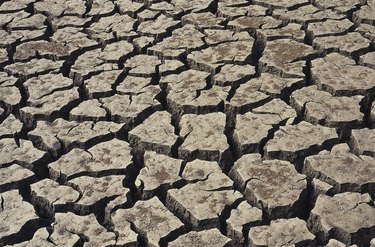Things You'll Need
Mortar and pestle
1/8-inch mesh screen
Graduated cylinder
Cotton ball
Distilled water
Calculator

Building on a soil with a large swell factor can be costly. Soils with a high percentage of swelling clay can be difficult to grow plants in because water may pool on the surface. Calculating the swell factor of soil depends on the amount of water it can hold. The swell factor of some soils can be high and create enough force to break concrete. A simple test of the soil can tell you how much it may swell.
Soil Sample Preparation
Step 1
Measure about a cup of soil. Let it sit for 48 hours to become air dry.
Video of the Day
Step 2
Pulverize all the soil clods, using a mortar and pestle. There is no need to grind up plant debris, gravel or sand.
Step 3
Sift the soil though a small mesh screen.
Swell Factor
Step 1
Put an inch of soil in a graduated cylinder. You could also fill the graduated cylinder to a line about an inch from the bottom. Either way, note the exact height of the soil in the cylinder.
Step 2
Place a cotton ball lightly over the soil. This will prevent the soil from becoming too stirred up when you add water.
Step 3
Add distilled water to the graduated cylinder until 3 inches of water covers the soil.
Step 4
Leave the soil in the water for 24 hours.
Step 5
Measure the change in the height of the soil. Calculating the percentage change in height from the wet soil to the dry will give you a measure of the swell factor of the soil. For example, if the dry soil was 1 inch high and the wet soil is 1.54 inches high, divide 1 by 1.54 and multiply by 100 to get a 65 percent swell factor.
Video of the Day